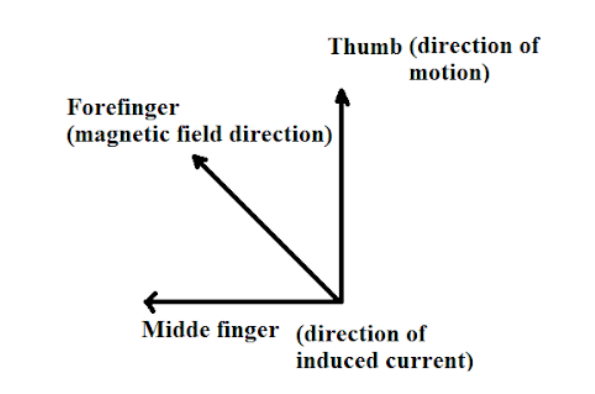
In Fleming’s right hand rule middle finger indicates the direction of
A. Magnetic field
B. Induced electric current
C. Mechanical energy
D. Motion of the conductor.
Answer
477.3k+ views
3 likes
Hint: Fleming’s right hand rule states that if the fore finger, middle finger and the thumb of the right hand are stretched in such a way that all the three are mutually perpendicular to each other, so that the fore finger points to the direction of the magnetic field, the thumb points to the direction of the motion of the conductor relative to the magnetic field, and the middle finger represents the direction of the induced current within the conductor from lower potential terminal to higher potential terminal.
Complete step-by-step solution:

So, according to Fleming's right hand rule, the middle finger of the right hand points to the direction of the induced current within the conductor and the current always flows from terminal of higher potential to the terminal of lower potential. This rule is useful in obtaining the direction of the current in most electric generators. So the middle finger points to the direction of induced current as shown in the figure.
Therefore, option (B) is the correct answer.
Note: Fleming’s right hand rule can be used to obtain the direction of current in a generator's windings. Fleming’s left hand rule should not be confused with Fleming’s right hand rule. It should be noted that Fleming's left-hand rule is used for electric motors, while Fleming's right-hand rule is used for electric generators. The right-hand rule is based on the underlying physics that connects the magnetic fields and the forces that they exert on moving charges, it just represents an easy way for physicists to remember the directions that things are supposed to point.
Complete step-by-step solution:

So, according to Fleming's right hand rule, the middle finger of the right hand points to the direction of the induced current within the conductor and the current always flows from terminal of higher potential to the terminal of lower potential. This rule is useful in obtaining the direction of the current in most electric generators. So the middle finger points to the direction of induced current as shown in the figure.
Therefore, option (B) is the correct answer.
Note: Fleming’s right hand rule can be used to obtain the direction of current in a generator's windings. Fleming’s left hand rule should not be confused with Fleming’s right hand rule. It should be noted that Fleming's left-hand rule is used for electric motors, while Fleming's right-hand rule is used for electric generators. The right-hand rule is based on the underlying physics that connects the magnetic fields and the forces that they exert on moving charges, it just represents an easy way for physicists to remember the directions that things are supposed to point.
Recently Updated Pages
Master Class 12 Business Studies: Engaging Questions & Answers for Success

Master Class 12 English: Engaging Questions & Answers for Success

Master Class 12 Social Science: Engaging Questions & Answers for Success

Master Class 12 Chemistry: Engaging Questions & Answers for Success

Class 12 Question and Answer - Your Ultimate Solutions Guide

Master Class 12 Economics: Engaging Questions & Answers for Success

Trending doubts
Give 10 examples of unisexual and bisexual flowers

Draw a labelled sketch of the human eye class 12 physics CBSE

Differentiate between homogeneous and heterogeneous class 12 chemistry CBSE

Write a short note on Franklands reaction class 12 chemistry CBSE

Differentiate between insitu conservation and exsitu class 12 biology CBSE

What are the major means of transport Explain each class 12 social science CBSE




